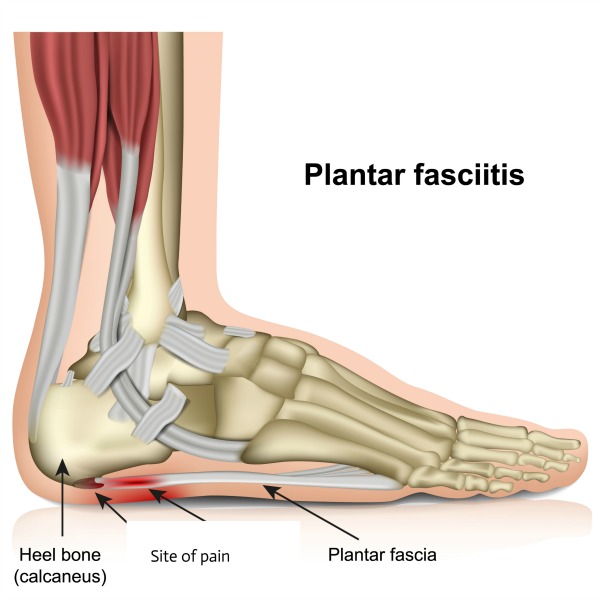Plantar Fasciitis is only one of the many causes of heel pain that you might experience (There is a list of over 40 possible causes!) but it is certainly the most common with approximately 80% of all heel pain being caused by this debilitating condition. About 10% of people will suffer from it in their lifetime.
The plantar fascia is a band of thick fibrous connective tissue that runs from the base of the calcaneus - your heel bone - along the sole of the foot ,and inserts at the base of the toes. In some people the fibres from the plantar fascia wrap around the heel and become the base of the Achilles tendon which causes the calf muscle, Achilles tendon and plantar fascia to be one continuous structure. This is not the only item along the sole of the foot. There are 4 layers of muscle below the plantar fascia as well as nerves, blood vessels, ligaments, tendons and fat pad which is why it is so important if you have heel pain to seek advice from a professional who can accurately diagnose the true cause of your heel pain as it may make a huge difference in solving the problem and getting you back on your feet!
It plays a huge role in your gait cycle and can be likened to a tough spring. As your heel hits the ground at the beginning of your step, you rock over your heel, your foot pronates and your arch lowers as you progressively load the foot. The plantar fascia is put under increasing tension and like a truss on a bridge, packs the foot bones above it together creating a very stable, strong structure that can resist the forces being loaded upon it and stops you from falling over in a wobbly mess. As you progress through the step you then pivot over the ankle joint (assuming you don’t have tight calf muscles which can mess that bit of your step up!), the other leg swings through the air, your weight transfers over the ball of the foot and you begin to pivot over the big toe joint. This tightens the plantar fascia even further as it gets wrapped around the bending toes and is called the ‘windlass’ effect. The effect of this is to supinate the foot which makes the arch raise and shorten the foot. As you keep moving forward the heel lifts and the plantar fascia recoils as the tension is released, further helping to lift the heel and contributing to propelling you forward ready to put your other foot down and do it all over again.
Often in true plantar fasciitis the pain will be worse as your heel leaves the floor as the recoil action occurs. If you get pain at other moments such as contact it may be that the plantar fat pad has become irritated and if you get pain at rest there may be some bone irritation involved as well.
Plantar fasciitis pain is usually characterised by pain in the middle of the heel and sometimes running into the arch of the foot. Often it starts slowly and symptoms of pf often include pain on first standing. So often people will describe that their pain is worst first thing in the morning when they get out of bed or will be painful after sitting down and resting for a while. Initially walking around will ease it and often the foot feels fine during activity. As the symptoms worsen it will often start to become uncomfortable towards the end of activity or after prolonged periods of standing and in severe cases can end up causing pain most of the time.
Often plantar fasciitis is caused by a change. I will commonly see people who have plantar fasciitis after increasing their activity levels, maybe after starting to walk to work or taking up a new fitness regime. A change in shoes, where perhaps the shoes are too stiff and hard for the activities being asked of it (for example walking to work in stiff work shoes) or too flat and not supportive enough. I regularly have people telling me that their symptoms started after wearing flat flip flops or shoes on holiday and walking around on uneven terrain. There is a link between being overweight and plantar fasciitis and you are more likely to get it between the ages of 40 -60. For many people this condition will resolve on its own within 12-18 months but this can be speeded up considerably by taking some very simple measures.
